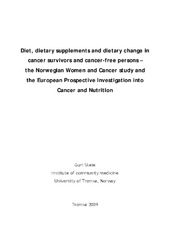The fraction of breast cancer attributable to smoking: The Norwegian women and cancer study 1991–2012
| dc.contributor.author | Gram, Inger Torhild | |
| dc.contributor.author | Little, Melissa A | |
| dc.contributor.author | Lund, Eiliv | |
| dc.contributor.author | Braaten, Tonje | |
| dc.date.accessioned | 2017-03-07T14:30:28Z | |
| dc.date.available | 2017-03-07T14:30:28Z | |
| dc.date.issued | 2016-06-09 | |
| dc.description.abstract | Background: Results from several recent cohort studies on smoking and breast cancer incidence and mortality suggest that the burden of smoking on society is underestimated. We estimated the fraction of breast cancer attributable to smoking in the Norwegian Women and Cancer Study, a nationally representative prospective cohort study. <br> Methods: We followed 130 053 women, aged 34–70 years, who completed a baseline questionnaire between 1991 and 2007, through linkages to national registries through December 2012. We used Cox proportional hazards models to estimate hazard ratios (HRs) with 95% confidence intervals (CIs), while adjusting for confounders. Never smokers, excluding passive smokers, were used as the reference group in all main analyses. We estimated attributable fractions (AFs) % in smokers and in the population (PAFs) % with 95% CIs. <br> Results: Altogether, 4132 women developed invasive breast cancer, confirmed by histology. Compared with never active, never passive smokers, ever (former and current) smokers had an overall risk of breast cancer that was 21% higher (HR¼1.21; 95% CI¼1.08–1.34). For ever smokers, the AF was 17.3% (95% CI ¼7.4–25.4) and for the population the PAF of breast cancer was 11.9% (95% CI¼5.3–18.1). For passive smokers, the PAF of breast cancer was 3.2% (95% CI¼1.0–5.4). When we applied PAF estimates for ever smoking on the 2907 new breast cancer cases among Norwegian women aged 35þ at diagnosis in 2012, this yielded 345 (95% CI¼154–526) breast cancer cases that could have been avoided in the absence of active smoking that year. <br> Conclusions: In smokers, one in six and in the population, one in nine breast cancer cases could have been avoided in the absence of active smoking. Our findings support the notion that the global cancer burden due to smoking is substantially underestimated. | en_US |
| dc.description | Published version. Source at <a href=http://dx.doi.org/10.1038/bjc.2016.154> http://dx.doi.org/10.1038/bjc.2016.154 </a> | en_US |
| dc.identifier.citation | Gram, I. T., Little, M. A., Lund, E., Braaten, T.: The fraction of breast cancer attributable to smoking: The Norwegian women and cancer study 1991–2012. British Journal of Cancer. 2016;115(5):616-623 | en_US |
| dc.identifier.cristinID | FRIDAID 1386975 | |
| dc.identifier.doi | 10.1038/bjc.2016.154 | |
| dc.identifier.issn | 0007-0920 | |
| dc.identifier.issn | 1532-1827 | |
| dc.identifier.uri | https://hdl.handle.net/10037/10469 | |
| dc.language.iso | eng | en_US |
| dc.publisher | Cancer Research UK | en_US |
| dc.relation.journal | British Journal of Cancer | |
| dc.rights.accessRights | openAccess | en_US |
| dc.subject | ever and passive smoking | en_US |
| dc.subject | avoidable breast cancer | en_US |
| dc.subject | breast cancer risk | en_US |
| dc.subject | cohort study | en_US |
| dc.subject | Norway | en_US |
| dc.subject | Norwegian Women and Cancer Study | en_US |
| dc.subject | population attributable fraction | en_US |
| dc.subject | smoking duration before first childbirth | en_US |
| dc.subject | VDP::Medisinske Fag: 700::Klinisk medisinske fag: 750::Onkologi: 762 | en_US |
| dc.title | The fraction of breast cancer attributable to smoking: The Norwegian women and cancer study 1991–2012 | en_US |
| dc.type | Journal article | en_US |
| dc.type | Tidsskriftartikkel | en_US |
| dc.type | Peer reviewed | en_US |


 English
English norsk
norsk


